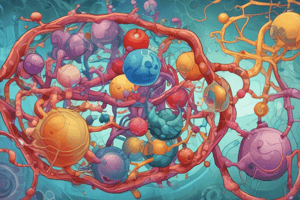Podcast
Questions and Answers
What is the primary function of the cell membrane?
What is the primary function of the cell membrane?
Which structure is responsible for synthesizing proteins?
Which structure is responsible for synthesizing proteins?
What do vacuoles primarily store in plant cells?
What do vacuoles primarily store in plant cells?
What is the role of the Golgi apparatus in a cell?
What is the role of the Golgi apparatus in a cell?
Signup and view all the answers
How do molecules typically move across a semi-permeable membrane?
How do molecules typically move across a semi-permeable membrane?
Signup and view all the answers
Study Notes
Chemistry of Life
- Biomolecules are single molecules that combine to form larger molecules (polymers)
- Carbohydrates are primarily for energy, with monosaccharides being the basic unit
- Lipids are for long-term energy storage and cell membrane structure
- Proteins are involved in enzymes, cell structure, growth, repair, and hormones; amino acids are the basic unit
- Nucleic acids store and transmit genetic information (DNA, RNA); nucleotides are the basic unit
- Enzymes are proteins that act as catalysts, speeding up chemical reactions by lowering activation energy. Active site shape is specific to substrate
- Enzyme function can be affected or stopped by changes in temperatures or pH if outside optimum range
Cell Energy
- Photosynthesis converts solar energy into chemical energy (glucose), using the formula: 6CO₂ + 6H₂O + light energy → C₆H₁₂O₆ + 6O₂
- Cellular respiration converts glucose into ATP (adenosine triphosphate), a high-energy molecule. The formula is: C₆H₁₂O₆ + 6O₂ → 6CO₂ + 6H₂O + 36 ATP
- Anaerobic respiration (fermentation) occurs without oxygen and produces 2 ATP
- Aerobic respiration utilizes oxygen and produces approximately 36 ATP in the mitochondria
Prokaryotic and Eukaryotic Cells
- Prokaryotic cells (bacteria) lack a nucleus and membrane-bound organelles
- Eukaryotic cells have a nucleus and membrane-bound organelles
Important Cell Structures
- Nucleus: holds DNA and controls cell activities
- Endoplasmic reticulum: network of tubes for transport
- Golgi apparatus: modifies, sorts, and packages materials for transport
- Vesicles: small sacs for carrying materials
- Vacuole: stores materials (especially in plant cells)
- Lysosome: breaks down cell materials
- Ribosomes: synthesize (make) proteins
- Mitochondria: site of cellular respiration
- Chloroplasts: site of photosynthesis
- Cell wall (in plants): structure and support; lacking in animal cells
Cell Transport
- Cell transport is about maintaining homeostasis (balance in the cell).
- Passive transport: molecules move down the concentration gradient (high to low concentration; no energy needed). Includes diffusion, facilitated diffusion, and osmosis.
- Active transport: molecules move against the concentration gradient (low to high concentration; requires energy, ATP).
Viruses
- Viruses are non-living agents requiring a host cell for reproduction
- Structure: protein capsid protects genetic material (DNA or RNA). Some have an outer envelope.
- Reproduction: lytic or lysogenic cycles, involving invading the host cell and using it for replication.
- Vaccines are weakened or dead viruses that create antibodies in the immune system
DNA and Cell Cycle
- DNA is a double-stranded helix with nitrogenous bases (A, T, G, C) pairing via hydrogen bonds to create a ladder-like structure
- DNA Replication occurs during the S phase of the cell cycle
- The cell cycle purpose is to create two daughter cells similar to the parent cell.
- Mitosis involves PMAT (Prophase, Metaphase, Anaphase, Telophase) which separates copied DNA and divides the nucleus
- Cytokinesis divides the cytoplasm
Heredity
- Heredity is the passing of traits from parents to offspring
- Genes are segments of DNA that code for proteins and determine traits
- Alleles are different forms of a gene
- Homozygous: two identical alleles (e.g., AA or aa)
- Heterozygous: two different alleles (e.g., Aa)
- Dominant alleles are expressed regardless (e.g., capital letters), recessive alleles are only expressed when both alleles are recessive (lower case letter)
- Genotype: the genetic makeup of alleles
- Phenotype: observable traits
- Monohybrid and dihybrid crosses: used to predict traits and ratios in offspring from different parents (using Punnett Square)
Studying That Suits You
Use AI to generate personalized quizzes and flashcards to suit your learning preferences.
Related Documents
Description
Test your knowledge on the chemistry of life, focusing on biomolecules and their roles in cells. This quiz covers carbohydrates, lipids, proteins, nucleic acids, as well as processes like photosynthesis and cellular respiration. Assess your understanding of how these components interact to sustain life.




